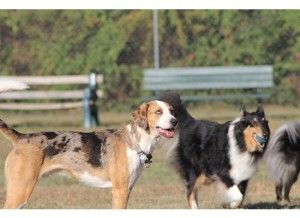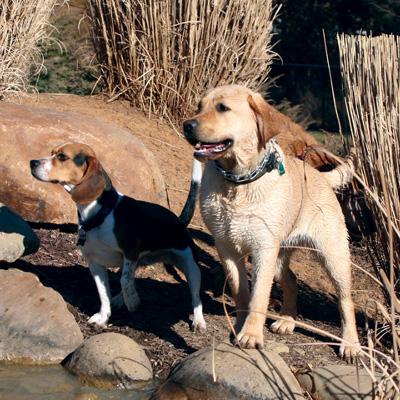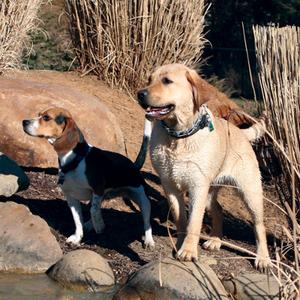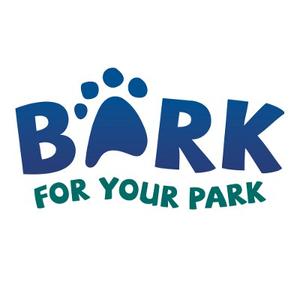 Dog parks can be a wonderful place to allow your dog to play and explore off-leash in a safe environment. Once you have established the few important things below, you will be ready to begin socializing your dog to the environment at the dog park.
Dog parks can be a wonderful place to allow your dog to play and explore off-leash in a safe environment. Once you have established the few important things below, you will be ready to begin socializing your dog to the environment at the dog park.
- Your dog has all the appropriate immunizations. Check with your veterinarian.
- Your dog is usually friendly around other animals. If your dog is shy, reactive or hasn’t been around other dogs you should consider a less overwhelming environment like a training class before checking out the dog park.
- You are prepared to supervise and interact with your dog at all times while at the park. The dog park is the place to be focused on your dog, not on your cell phone.
- Your dog has a good recall (come when called,) not just at home, so practice this before heading out anywhere your dog will be off-leash.
What is socialization and why is it important?
So you have determined your dog is a good candidate for the dog park environment and you are prepared to be a great dog park parent. Great, now let’s define socialization. 
Socialization is introducing the dog to novel environments, experiences, objects and others (be it dogs, men, women, children) AND making the introductions enjoyable and as stress free as possible so the dog develops good associations.
We often think of socialization for puppies as it is very important to their development into normal adult dogs. Well-socialized puppies develop far fewer behavior issues. Adult dogs can be socialized to new things with the same process.
The important part is to keep the introductions slow and ensure the dog is enjoying the experience. If the dog begins to show signs of stress, anxiety, fear or reactivity slow down, pull back and return to an earlier point in the introduction.
The dog park is not just one thing. It is a new environment filled with new dogs, people, objects, smells, sounds and experiences. The best you can do for your dog is to scope out any dog parks in your area before bringing your dog along. Check the park out at times you are most likely to go. Things to look for:
Park Facilities and Management
- Does the park have posted safety and conduct rules? Make note of these and whether those using the park are actually following the rules.
- Does the park have separate areas for small dogs and larger dogs? While this doesn’t ensure safe dog-dog interactions it is definitely a good start.
- Is the park well kept? It’s a dog park so there will be some dirt but the grass and other areas should be maintained, the fence should be secure, there should be waste stations and secure trash receptacles.
- Does the park have any equipment or obstacles for agility or play? These should be well-maintained, low to the ground and easy to ensure the safety of all the dogs. Dogs not trained for these things can be injured.
- Who manages the park? It could be the city, a private group or even volunteers. Check out any resources they have online.
People and Dogs
- Are the pet parents supervising and interacting with their pets? If they are spending more time chatting with each other and texting they are not going to be able to control their dog if play gets too rambunctious. They should be monitoring their dog at all times.
- Do all the dogs rush the gate when a new dog is entering? The pet parents should be encouraging their dogs to stay clear so others can enter safely.
- Does the dog play look friendly? Dogs who are playing are loose, wiggly and bouncy.
Once you have found a good dog park, plan a short first trip. You may not even go inside the park the first time. Pick a time when the park is not too busy. Early mornings are usually good. Evenings and after 9 am on the weekends are usually swamped.
Start by walking your dog on-leash outside the park and letting him check out all the sights, sounds and smells. If he approaches the fence calmly and looks happy to be there, feed him some treats. Careful with the treats, as it’s safest not to take a bunch of treats into the park or some dogs may mob you or display guarding around the treats.
Practice a few behaviors like sit or down. Practice approaching the gate calmly. If it is going well, take your dog in for quick off-leash lap around the inside of the park. Walk around with your dog. Talk to him, play and have fun. The dog park should always be fun for you and more importantly your dog. If at any time your dog seems, uncomfortable in the park or with any of the dogs or people you should leave.
Even if it is going well, keep this first visit short, no more than 20 minutes. Next time you can plan to stay a little longer if your dog is enjoying himself.
As your dog interacts with the other dogs at the park pay close attention to the dogs he enjoys playing with and which ones he ignores, or runs away from. Just like we don’t like everyone we meet, your dog won’t like every dog he meets. Introduce yourself to the pet parents of the dogs your dog likes to engage with and find out when they visit the park. It’s a great way to ensure your dog has a good time and make some new friends. The best dog parks have a community of pet parents who are regulars and help watch out for each other’s dogs.
Every time you visit the dog park, do a quick check before you go in the gate. Note any dogs, people, objects and sounds that may be new to your dog. Each trip will have a different set of variables and may present a socialization opportunity. Keep each interaction positive for your dog. Be prepared to leave or play away from some dogs if the situation is uncomfortable for your dog. With proper socialization, your dog should become happy to play at the park with other well socialized dogs. That doesn’t mean he will get along with every dog, especially if the other dog doesn’t have the best doggie manners. Not every dog enjoys the dog park and that’s OK. There are plenty of other options like agility, tricks, hiking, etc. that you can do with your dog.
While it’s great to practice some basic behaviors at the dog park, away from other dogs, and this can help build your dog’s confidence, I don’t recommend training new behaviors in midst of all the other dogs. Asking your dog to sit and stay while all the other dogs are sniffing his butt and in his face can be overwhelming and scary for any dog. If you need to get in some off-leash training head to the park very early and do it before everyone else starts arriving. So take it slow, observe your dog’s comfort level and have fun!





